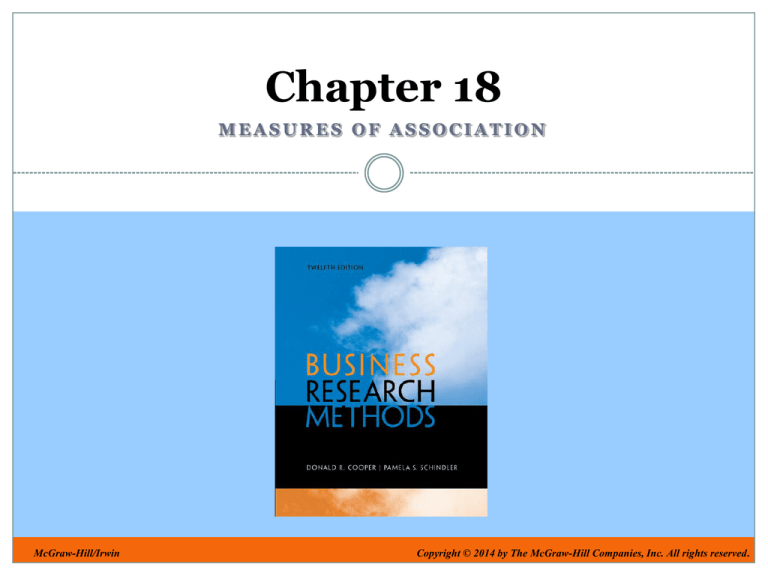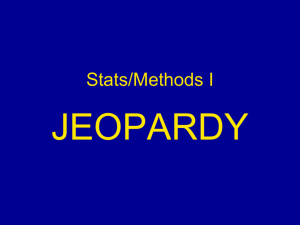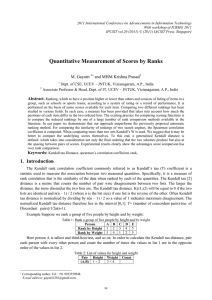
Chapter 18
MEASURES OF ASSOCIATION
McGraw-Hill/Irwin
Copyright © 2014 by The McGraw-Hill Companies, Inc. All rights reserved.
Learning Objectives
Understand . . .
How correlation analysis may be applied to
study relationships between two or more
variables
The uses, requirements, and interpretation of
the product moment correlation coefficient.
How predictions are made with regression
analysis using the method of least squares to
minimize errors in drawing a line of best fit.
18-2
Learning Objectives
Understand . . .
How to test regression models for linearity and
whether the equation is effective in fitting the
data.
Nonparametric measures of association and the
alternatives they offer when key assumptions
and requirements for parametric techniques
cannot be met.
18-3
Pull Quote
“Consumer behavior with digital editions of magazines is
very much like their behavior with print editions of
magazines, and very much unlike their behavior with
websites. Readers typically swipe through tablet editions
from front to back, for example, the same way they work
their way through print editions. They browse—taking in
ads as they go—instead of jumping directly to specific
articles the way web surfers do.”
Scott McDonald,
senior vice-president for research and insights,
Conde Nast
18-4
Measures of Association:
Interval/Ratio Data
Pearson correlation
coefficient
For continuous linearly related
variables
Correlation ratio (eta)
For nonlinear data or relating a
main effect to a continuous
dependent variable
Biserial
One continuous and one
dichotomous variable with an
underlying normal distribution
Partial correlation
Three variables; relating two with
the third’s effect taken out
Multiple correlation
Three variables; relating one
variable with two others
Bivariate linear regression
Predicting one variable from
another’s scores
18-5
Measures of Association:
Ordinal Data
Gamma
Based on concordant-discordant
pairs; proportional reduction in
error (PRE) interpretation
Kendall’s tau b
P-Q based; adjustment for tied
ranks
Kendall’s tau c
P-Q based; adjustment for table
dimensions
Somers’s d
P-Q based; asymmetrical
extension of gamma
Spearman’s rho
Product moment correlation for
ranked data
18-6
Measures of Association:
Nominal Data
Phi
Chi-square based for 2*2 tables
Cramer’s V
CS based; adjustment when one table
dimension >2
Contingency coefficient C
CS based; flexible data and distribution
assumptions
Lambda
PRE based interpretation
Goodman & Kruskal’s tau
PRE based with table marginals
emphasis
Uncertainty coefficient
Useful for multidimensional tables
Kappa
Agreement measure
18-7
Researchers
Search for
Insights
Burke, one of the world’s leading
research companies, claims
researchers add the most value to
a project when they look beyond
the raw numbers to the shades of
gray…what the data really mean.
18-8
Pearson’s Product Moment Correlation r
Is there a relationship between X and Y?
What is the magnitude of the relationship?
What is the direction of the relationship?
18-9
Connections and Disconnections
“To truly understand consumers’ motives
and actions, you must determine
relationships between what they think
and feel and what they actually do.”
David Singleton, vp of insights
Zyman Marketing Group
18-10
Scatterplots
of
Relationships
18-11
Scatterplots
18-12
Plot of
Forbes 500
Net Profits
with Cash
Flow
18-13
Diagram of Common Variance
18-14
Interpretation of Correlations
X causes Y
Y causes X
X and Y are activated by
one or more other variables
X and Y influence each
other reciprocally
18-15
Artifact
Correlations
18-16
Interpretation of Coefficients
A coefficient is not remarkable
simply because it is statistically
significant!
It must be practically meaningful.
18-17
Comparison
of Bivariate
Linear
Correlation
and
Regression
18-18
Examples of Different Slopes
18-19
Concept Application
X
Average Temperature (Celsius)
Y
Price per Case
(FF)
12
2,000
16
3,000
20
4,000
24
5,000
Mean =18
Mean = 3,500
18-20
Plot of Wine Price by Average
Temperature
18-21
Distribution
of Y for
Observation
of X
18-22
Wine
Price
Study
Example
18-23
Least
Squares Line:
Wine Price
Study
18-24
Plot of Standardized Residuals
18-25
Prediction and Confidence Bands
18-26
Testing Goodness of Fit
Y is completely unrelated to X
and no systematic pattern is evident
There are constant values of
Y for every value of X
The data are related but
represented by a nonlinear function
18-27
Components of Variation
18-28
F Ratio in Regression
18-29
F Ratio in Regression
18-30
Coefficient of Determination: r2
Total proportion of variance in Y
explained by X
Desired r2: 80% or more
18-31
ChiSquare
Based
Measures
18-32
Proportional
Reduction of
Error
Measures
18-33
Statistical Alternatives for Ordinal
Measures
18-34
Calculation of
Concordant (P),
Discordant (Q),
Tied (Tx,Ty),
and Total Paired
Observations:
KeyDesign
Example
18-35
KDL Data for Spearman’s Rho
_______ _____ Rank By_____ _____
_____
Applicant
Panel x
Psychologist y
d
d2
1
2
3
4
5
6
7
8
9
10
3.5
10.0
6.5
2.0
1.0
9.0
3.5
6.5
8.0
5.0
6.0
5.0
8.0
1.5
3.0
7.0
1.5
9.0
10.0
4.0
-2.5
5.0
-1.5
.05
-2
2.0
2.0
-2.5
-2
1.0
6.25
25.00
2.52
0.25
4.00
4.00
4.00
6.25
4.00
_1.00_
57.00
.
18-36
Key Terms
1837
Artifact correlations
Phi
Bivariate correlation
Coefficient of
analysis
Bivariate normal
distribution
Chi-square-based
measures
Contingency coefficient
C
Cramer’s V
determination (r2)
Concordant
Correlation matrix
Discordant
Error term
Goodness of fit
lambda
18-37
Key Terms
1838
• Linearity
• Pearson correlation
• Method of least squares
• Ordinal measures
•
• Gamma
• Somers’s d
•
• Spearman’s rho
• tau b
•
• tau c
•
coefficient
Prediction and
confidence bands
Proportional reduction
in error (PRE)
Regression analysis
Regression coefficients
18-38
Key Terms
1839
• Intercept
• Scatterplot
• Slope
• Simple prediction
• Residual
• tau
18-39
Chapter 18
ADDITIONAL DISCUSSION OPPORTUNITIES
McGraw-Hill/Irwin
Copyright © 2014 by The McGraw-Hill Companies, Inc. All rights reserved.
Snapshot: Oscars
Does the Oscar have any measurable
effect on movie viewership?
Brief online survey via OmniPulse.
Event hype only a small influence.
Do women respond differently than men?
18-41
PicProfile: Constellation Wines
Recession affected wine behavior.
Positioning research using focus groups.
Word sorts to reveal how Blackstone
compared to other brands.
‘Masculine’ wasn’t threatening
but a strength.
Three ads by Amazon Advertising were
tested; “Count on it” strongest.
18-42
Snapshot: Environsell
Does how you drive affect how you shop?
Envirosell tracked shoppers’ behaviors.
Observation studies.
Brits and Aussies shop as they drive.
18-43
Snapshot: Advanced Statistics
“A risk score model was embedded
in the daily transactions processing
system to automatically determine
how much cash each member can
withdraw from an ATM or receive
when making deposits.”
18-44
Pull Quote
“The invalid assumption that correlation
implies cause is probably among the two
or three most serious and common errors
of human reasoning.”
Stephen Jay Gould
paleontologist and science writer
18-45
PulsePoint:
Research Revelation
25
The percent of students using a
credit card for college costs due
to convenience.
18-46
Chapter 18
MEASURES OF ASSOCIATION
McGraw-Hill/Irwin
Copyright © 2014 by The McGraw-Hill Companies, Inc. All rights reserved.
Photo Attributions
Slide Source
8 Courtesy of Burke Research Inc.
41 ©Image Source, all rights reserved
42 Purestock/SuperStock
43 Purestock/SuperStock
44 Comstock Images/Getty Images
18-48







